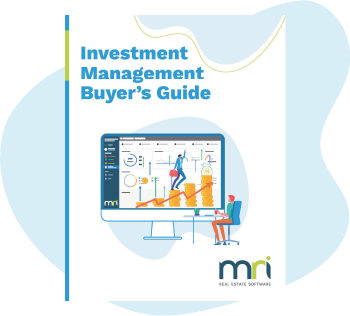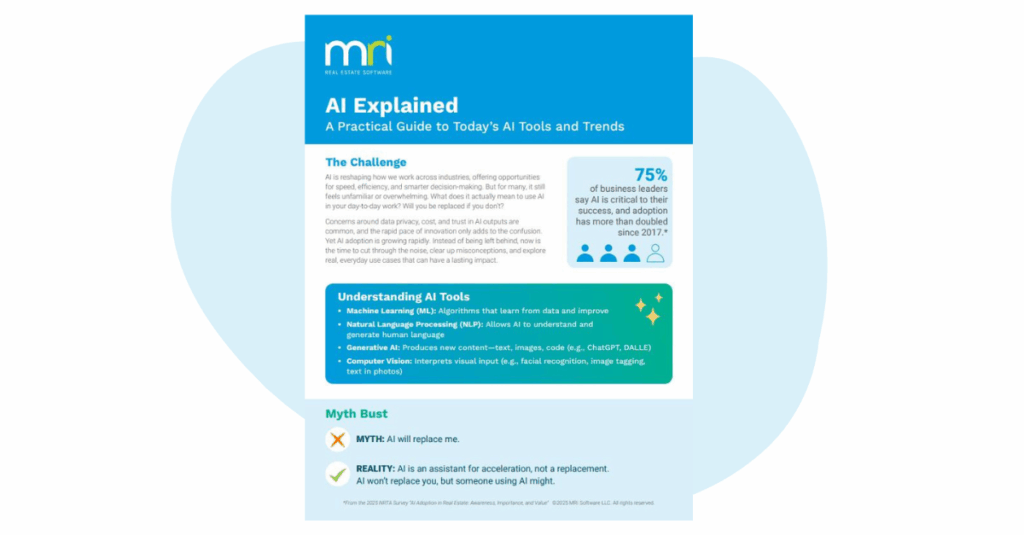What are CRE investments? Exploring their benefits, returns, and risks
Commercial real estate (CRE) investments are a time-tested strategy for building wealth and generating steady income. These investments make up nearly one-third of the U.S. real estate market, highlighting their significant role for landlords and investors alike. Whether you’re managing a growing portfolio or considering your first CRE investment, understanding how these investments work is crucial to your financial success.a
In this guide, we’ll explore everything you need to know about CRE investments, including their benefits, returns, and associated risks. You’ll gain insight into how CRE properties can help diversify your portfolio while generating consistent cash flow. Plus, we’ll discuss what is CRE investing and how tools like MRI Software can simplify portfolio management and position you for long-term success.
What are CRE investments?
CRE, or commercial real estate, refers to properties designed for business purposes that generate income for their owners. These properties include offices, retail spaces, multifamily housing, and industrial facilities, each serving tenants with unique needs. Unlike residential real estate, which focuses on personal living spaces, CRE caters to tenants who use the property to run businesses or other income-producing activities.
What makes CRE investments particularly appealing is their ability to deliver steady cash flow, benefit from tax advantages, and appreciate in value over time. For instance, a well-managed retail plaza with popular stores can generate consistent rental income while gaining value in a growing market. Understanding what is CRE investment and how it aligns with your goals is key to making informed decisions in this growing sector.
Types of CRE
CRE properties span a wide range of asset types, each offering distinct opportunities and challenges for landlords. Multifamily properties, such as apartment complexes with five or more units, provide reliable income thanks to strong demand for rental housing. Office spaces, which house business tenants, often offer long-term leases that ensure predictable and stable cash flow.
Retail properties like shopping centers, strip malls, or standalone stores rely on thriving businesses to maintain profitability. Industrial properties, including warehouses and distribution centers, have seen a surge in demand with the rapid growth of e-commerce and logistics needs. Each CRE type presents unique advantages, making it essential for investors to choose properties that align with their financial goals and insights into CRE development investments.
Benefits of CRE investments
CRE investments offer a wide range of benefits that make them a compelling choice for landlords aiming to grow wealth and secure steady income. From consistent rental payments to long-term property appreciation, these assets provide financial stability and growth opportunities. Their ability to diversify portfolios makes them a favorite among seasoned investors.
Regular income through rent
A key advantage of CRE investments is their ability to deliver reliable rental income. Tenants, often on long-term leases, provide a consistent monthly cash flow that landlords can depend on. This income not only covers operational expenses but also generates profits that can be reinvested in new properties or other ventures.
Multifamily properties, for example, often experience lower vacancy rates due to high demand for rental housing. Office leases, which commonly last several years, further enhance financial predictability for landlords. Compared to the volatility of stocks, CRE’s steady income streams make it a safer and more reliable option for those engaging in CRE investing.
Appreciation potential
CRE properties typically appreciate in value over time, offering significant long-term wealth-building opportunities for investors. High-demand areas, like thriving metropolitan regions, often see faster value growth as populations and businesses expand. Landlords can also boost appreciation by making strategic upgrades, such as modernizing facilities or improving amenities.
According to industry reports, CRE properties typically have an annual return of 6–12%, depending on factors like location and market conditions. This is much higher than single family home properties which typically have returns between 1% to 4%. By maintaining properties and leveraging CRE development investments, landlords can ensure maximum value growth over time.
Tax advantages
CRE investments come with notable tax benefits, making them a highly efficient tool for wealth building. Owners can take advantage of depreciation deductions, which lower taxable income by accounting for the natural wear and tear on the property. Programs like the 1031 Exchange allow landlords to defer capital gains taxes by reinvesting in similar properties.
For example, a landlord could sell a multifamily complex and reinvest in a retail property, avoiding immediate tax liabilities while expanding their portfolio. These tax strategies are powerful for preserving profits and scaling investments over time. By leveraging these opportunities, landlords can significantly enhance their net returns while strengthening their approach to CRE investing.
Diversification
Diversification is one of the most valuable benefits of CRE investments, helping landlords balance risks across their portfolios. Unlike stocks or bonds, which can be highly volatile, real estate provides consistent returns even during economic downturns. Different CRE types, such as industrial properties and multifamily housing, offer varied income streams that further reduce overall risk.
For example, while retail properties may be sensitive to consumer demand, multifamily housing remains steady due to constant rental needs. This balance helps investors weather market fluctuations and maintain portfolio stability. Adding CRE to an investment strategy strengthens financial resilience and supports sustainable long-term growth.
Returns on CRE investments
Understanding the returns on CRE investments is crucial for evaluating their profitability and making informed decisions. These returns are typically derived from rental income, property appreciation, and other ancillary revenue streams. By effectively measuring and managing these returns, landlords can maximize their investment potential and achieve long-term financial goals.
Types of return
CRE investments provide returns primarily through two channels: rental income and property appreciation. Rental income offers a reliable cash flow, with tenants paying rent that can be used to cover expenses and generate profits. Appreciation, on the other hand, boosts the property’s value over time, allowing investors to realize significant capital gains when they sell.
Some CRE properties also produce ancillary income from additional services or features. For instance, an office building may generate extra revenue by leasing premium parking spaces to tenants or visitors. Similarly, industrial properties benefit from the growing logistics sector, which drives higher demand and profitability.
Measuring returns
To accurately evaluate returns, landlords use metrics such as capitalization rate (cap rate) and cash-on-cash return. The cap rate assesses a property’s annual net operating income as a percentage of its purchase price, offering a quick way to compare profitability. Meanwhile, cash-on-cash return focuses on the income earned relative to the investor’s initial cash investment.
For example, a property with a cap rate of 7% would yield annual returns equal to 7% of its market value, providing a clear indicator of its earning potential. Cash-on-cash return is particularly useful for understanding short-term performance, especially for financed investments. By leveraging these metrics, landlords can identify high-yield opportunities and optimize their commercial real estate strategy.
Risks associated with CRE investing
While CRE investments come with numerous benefits, they also carry risks that require careful management. Factors like market trends, economic shifts, and property-specific issues can impact profitability. By understanding these risks and implementing commercial real estate risk management strategies, landlords can safeguard their investments and ensure stability.
Market risks
Market fluctuations, such as changing tenant demand or an oversupply of properties, can lead to higher vacancy rates. For example, an area saturated with office spaces might struggle to find tenants, forcing landlords to lower rents or leave spaces vacant. To reduce market risks, landlords should research local trends and target properties in regions with stable demand and growth potential.
Economic factors
Broader economic factors, such as recessions or rising inflation, can affect tenants’ ability to pay rent and increase property-related expenses. During a downturn, retail tenants might face reduced sales, making it harder for them to meet their lease obligations. Staying informed about economic conditions and adjusting strategies accordingly is critical for mitigating these risks.
Property-specific risks
Every CRE property comes with unique challenges that can impact its performance and value. Poor maintenance, for instance, can lower tenant satisfaction, while a property in a declining neighborhood may struggle to attract leases. Addressing these risks requires investing in regular upkeep, responsive management, and strategic location choices to enhance tenant retention and property appeal.
Financing and interest rates risks
Many CRE investments involve substantial financing, making them sensitive to changes in interest rates. Higher interest rates can increase borrowing costs, reducing overall profitability for landlords. To protect against these risks, investors can secure favorable loan terms, lock in fixed-rate financing, or reduce reliance on debt when feasible.
Optimize your CRE investments with MRI Software
MRI Software offers landlords powerful tools to simplify operations and maximize the value of their CRE investments. With its commercial real estate investment software, landlords can automate rent collection, monitor tenant accounts, and analyze property performance in real-time. These features not only reduce administrative workloads but also help landlords manage their portfolios more efficiently.
Investment Management Buyer's Guide
Reduce risk and attract investors with real estate investment management technology

AI Explained: A Practical Guide to Today’s AI Tools and Trends
AI is reshaping how we work across industries, offering opportunities for speed, efficiency, and smarter decision-making. But for many, it still feels unfamiliar or overwhelming. What does it actually mean to use AI in your day-to-day work? Will you …
